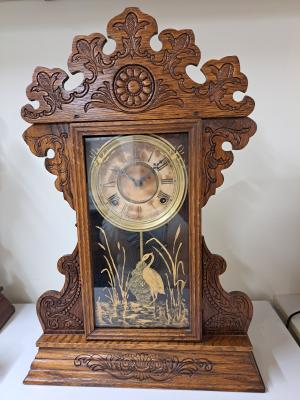Willow pattern Milk Jug
1938A footed, squat oval shaped pottery milk jug with a spout encompassed by a blue willow pattern transfer of 3 men on a bridge. The willow pattern does not encompass the handle and a blue painted line runs round the top of the jug and the outer side of the handle. The pattern is a softer/rounder version than the normal darker version. The top and bottom rims of the jug are oval shaped and the spout has a chip.
The Royal Doulton company began in 1815 as a partnership in a factory at Vauxhall Walk, Lambeth which traded as Jones, Watts & Doulton until 1820, when the trade name was changed to Doulton & Watts. They specialised in making stoneware like bottles, jugs and jars, much of it intended for inns and pubs. In 1826 it moved to a pottery on Lambeth High Street, in 1854 it took the name Doulton & Co and by 1897 employed over 4,000 workers.
In 1846 Doulton & Co started manufacturing circular ceramic sewage pipes and the advent of 1846–1860 cholera pandemic in London, which led to the massive upgrade sewage management in London, was advantageous to the business.
By the 1860s the company became interested in more artistic wares and started experimenting with glazes and making refined stoneware to compete with porcelain. From 1871 Doulton offered work to designers and artists and pieces from this period were signed by the artists, usually with initials or a monogram incised on the base. Many are also dated. Until 1882, "every piece of the company's art stoneware was a unique item". In 1882, Doulton purchased the small factory of in Burslem, Staffordshire, which placed Doulton in the region known as The Potteries.
Details
Details
On the base of the jug is the Royal Doulton mark including the wording
MADE IN ENGLAND
ROYAL DOULTON
ENGLAND
This jug was made by Royal Doulton in the 1930s and features willow pattern which is thought to have been invented by either Minton or Josiah Spode in the 1790s to feed the public demand for "Chinoserie" at the time.
The design of the Willow Pattern is thought to have been inspired by a Japanese fairy tale called The Green Willow and Chinese variants of it which tells of two thwarted lovers. Then, in 1849, an article called ‘The Story of the Common Willow Pattern Plate’ was published in The Family Friend magazine. It set out the following narrative that has become the standard interpretation of the pattern.
The story tells how Koong-se, the beautiful daughter of a wealthy Mandarin, fell in love with Chang, his low-born assistant. When the Mandarin found out he banished Chang and built a great fence around his property to keep his daughter in and Chang out. The Mandarin arranged a betrothal for Koong-se with a rich and powerful Duke, who arrived by boat carrying a casket of jewels as a marriage offering. While the Mandarin and Duke got drunk together, Chang broke into compound and escaped with Koong-se taking the jewels. The Mandarin, Duke and one of his men gave chase but the couple got away. They ended up living happily on a far away island where Chang made a successful living as a writer. In fact, he was too successful and his fame reached the ears of the Mandarin. He sent his henchmen over to the island where they killed Chang and set fire to the house, killing Koong-se who was inside. The Gods, seeing their plight, immortalised them as two doves which you can see flying together at the top of the Willow Pattern. Other elements of the story such as the Duke arriving by boat, three men giving chase over the bridge, and even the far away island can be seen in the pattern.
Burslem
Other items from Busselton Historical Society
- Cardinal Wolsey Milk Jug
- Pressed Glass Fruit Bowl
- Biscuit Barrel
- Biscuit Barrel
- Sheffield Stainless Steel Cheese Knife
- Cut Glass Decanter with Stopper
- Sheraton Ivory Vegetable Dish with Lid
- Floral Patterned Cheese Dish with Lid
- SESSION GINGERBREAD CLOCK
- Pressed Glass Water Jug
- Glass Compote Bowl
- Dessert Serving Dish
Scan this QR code to open this page on your phone ->



